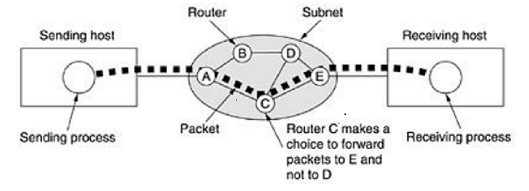LAN-Local Area Networks
Local area networks, generally describe LANs, are privately-owned networks within a single building or campus of up to a few km in size. They are generally used to attach personal computers and workstations in company offices and factories to share resources such as printers and exchange in order. LANs are well-known from other kinds of networks by three characteristics:
1) Their size,
2) Their transmission technology, and
3) Their topology.
LANs are restricted in size, which means that the worst-case transmission time is enclosed and known in move ahead. Knowing this bound makes it possible to use sure kinds of designs that would not otherwise be probable. It simplifies scheme organization. LANs might use a broadcast technology consisting of a cable to that all the machines are attached, as the telephone company party lines on one occasion used in rural areas. Customary LANs run at speeds of 10 Mbps to 100 Mbps, have low delay (microseconds or nanoseconds), and make few errors. New LANs operate at up to 10 Gbps various topologies are possible for broadcast LANs.
In a bus (i.e., a linear cable) network, at any instant at most one machine is the master and is allowed to transmit. All another one machines are necessary to refrain from sending. An adjudication mechanism is essential to resolve conflicts when two or more machines want to transmit at the same time. The arbitration mechanism may be centralized or distributed. IEEE 802.3, popularly identify Ethernet, such as is a bus-based broadcast network with decentralized manage, typically operating at 10 Mbps to 10 Gbps. Computers on an Ethernet could transmit whenever they want to; if two or more packets collide, each computer waits random time and tries again later.
A second type of broadcast system is the ring. In ring, every bit propagates around on its own , not waiting for the remaining packet to that it belongs. Typically, both bits circumnavigate the entire ring in the time it takes to transmit a few bits, often before the whole packet has been transmitted. As with all broadcast systems, some rules are needed for arbitrating immediate accesses to the ring. Various techniques, as in having the machines take turns, are in use. IEEE 802.5 (the IBM token ring), is a ring-based LAN effective at 4 and 16 Mbps. FDDI is an example of ring network.

A() Metropolitan Area Network:
A metropolitan area network or MAN covers the city. The well known example of a MAN is the cable television network available in many cities. This system produced from previous community antenna system used in areas with poor over-the-air television reception. In these early systems, a large antenna was placed on top of a nearby hill and signal was piped to the subscribers'' houses.
At first, these were locally-designed, ad hoc systems. Then companies started on jumping into the business, realization contracts from city governments to wire up the entire city. The next step was television programming and even entire channels designed for a cable only. Often these channels were highly specialized, as in all news, all sports, all cooking, and all gardening. But from their inception till the late 1990s, they were projected for television reception only.
To the first approximation, MAN may look something like the system; both television signals and Internet are fed into the middle head end for subsequent distribution to people home.
Cable television is not an only MAN. New developments in high-speed wireless Internet access resulted in a new way MAN, which has been standardized as IEEE 802.16. A MAN is put into practice by a standard called DQDB such as Distributed Queue Dual Bus or IEEE 802.16. DQDB has two unidirectional buses and cables to which the computers are attached.